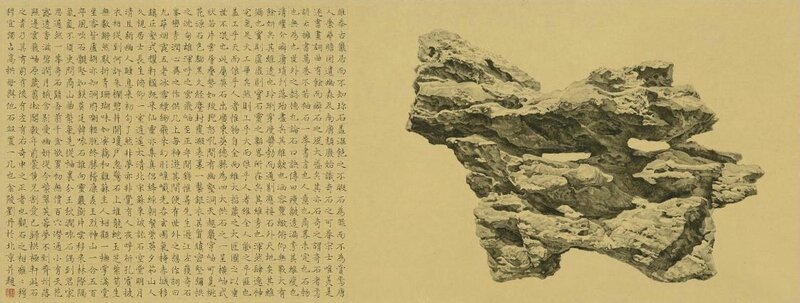Liu Dan (B. 1953), Spirit Rock
Lot 3020. Liu Dan (B. 1953), Spirit Rock. Scroll, mounted and framed. Ink on paper, 52 x 136 cm. (20 ½ x 53 ½ in.). Estimate HK$1,800,000 – HK$2,800,000 ($232,889 - $362,272). Price Realized HK$6,280,000 ($812,523). Photo Christie's Image Ltd 2016.
“One of the main paradoxes of Liu Dan’s work is that the ‘form of no-form’ or wu xing is achieved not through the blurry and vague but through the precise and clear… The precise is not a means of capturing or affirming appearance but a means of disconcerting and destabilising appearance, even as it holds on to it.”
Professor Ackbar Abbas
Liu Dan began to study Confucian classics and calligraphy at an early age with his grandfather, and later attended the Jiangsu Traditional Chinese Painting Institute where he studied under artist Ya Ming. He began to associate his art with classical Chinese painting only upon moving to the United States in 1981. It was in the US that he found unprecedented opportunities to learn from the museum collections of classical paintings there. His interest in classical civilisations and their artistic achievements however is not exclusively concerned with China; his research of great works of art is extensive, including both Chinese and Mediterranean classics, as well as Medieval and Renaissance Europe. This spectrum of influence has provided nutrients for his creativity and speaks loudly to the universality of his art; his work is intrinsically Chinese but it speaks to all viewers.
Through Liu Dan’s meticulous, precise painting one can observe a great paradox in the liberating power of self-discipline. Liu Dan is a strikingly innovative painter who uses his mastery of traditional method and technique to free his paintings from the aesthetic constraints normally associated with Chinese ink paintings. He does this while remaining true to the tradition, with results that are spectacularly novel and contemporary. The artist is keen to emphasise that his attainment of masterly skill through self-discipline is what provides him with the freedom to paint according to his heart and mind. In Spirit Rock, his freedom is used to scrupulously render minute and almost photographic details of a scholar’s rock.
Spirit Rock is a magnificent example not merely of Liu Dan’s superb painterly skills in ink and brush but of how his journey and aspiration empowered him to pursue perfection in his art. Historically prized in traditional Chinese literati culture, scholar’s rock has been an object of admiration and a vehicle for scholars to contemplate their aspirational values. For Liu Dan, rocks are “a symbolic microcosm of the material world” and his rock paintings are his attempts to transform a tangible object into an imaginary landscape for the heart of the viewer. His ability to “turn images into indescribable illusions by manipulating their familiar features” offers viewers a way to discover new perspectives through the fine details of common objects. Spirit Rock comes from the Guangdong city of Yingde and is one of the four most celebrated scholar’s rocks. Its shape resembles the layering of clouds and it exudes the vigour of a beast. Through traversing the contours of the rock, one can see paradise from the holes and crevices. Spirit Rock has been portrayed by the artist in his various compositions. In the inscription of the painting, the artist speaks of how the rock came to his collection and praises the grotesqueness of the rock which can be appreciated from the front, the back, the left and the right.

/https%3A%2F%2Fprofilepics.canalblog.com%2Fprofilepics%2F1%2F0%2F100183.jpg)
/https%3A%2F%2Fstorage.canalblog.com%2F03%2F02%2F119589%2F96711876_o.jpg)
/https%3A%2F%2Fstorage.canalblog.com%2F11%2F31%2F119589%2F94773502_o.jpg)
/https%3A%2F%2Fstorage.canalblog.com%2F20%2F83%2F119589%2F94772815_o.jpg)
/https%3A%2F%2Fstorage.canalblog.com%2F26%2F72%2F119589%2F75604929_o.jpg)
/https%3A%2F%2Fstorage.canalblog.com%2F59%2F60%2F119589%2F26458628_o.jpg)






/http%3A%2F%2Fstorage.canalblog.com%2F80%2F29%2F119589%2F125978103_o.jpg)
/http%3A%2F%2Fstorage.canalblog.com%2F57%2F10%2F119589%2F125947143_o.jpg)
/http%3A%2F%2Fstorage.canalblog.com%2F44%2F65%2F119589%2F110896902_o.jpg)
/http%3A%2F%2Fstorage.canalblog.com%2F44%2F89%2F119589%2F109652725_o.jpg)